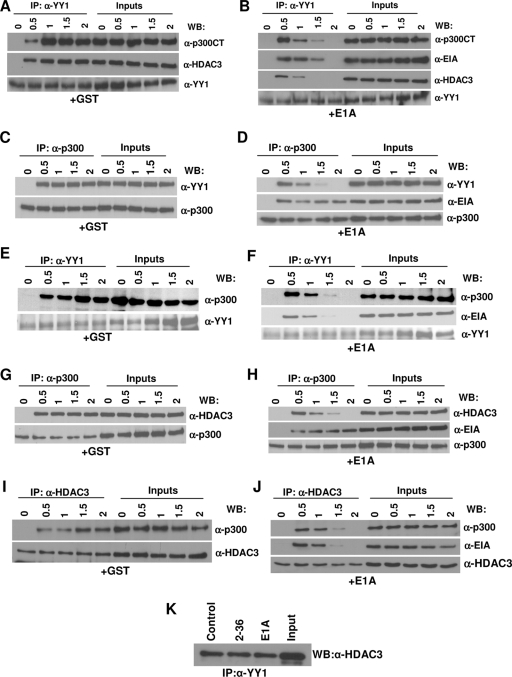FIG. 7.
Binding of E1A to p300 in the p300 protein complexes leads to the dissociation of YY1 and HDAC3 from the complex in vitro. (A and B) Association of E1A with the trimolecular complex at early time points during incubation and dissociation of the complex as a function of time. p300, YY1, HDAC3, and E1A (B) or GST (A) were mixed and incubated on ice. At the indicated time points, proteins were immunoprecipitated with an anti-YY1 antibody, and the coimmunoprecipitated proteins were identified by Western blotting with antibodies as indicated. α-p300CT, anti-p300CT antibody; α-HDAC3, anti-HDAC3 antibody; α-YY1, anti-YY1 antibody. (C to F) Effect of E1A on YY1-p300 complex formation. YY1, p300, and GST (C and E) or E1A (D and F) were mixed, incubated on ice, and coimmunoprecipitated with anti-p300 (C and D) or anti-YY1 (E and F) antibodies at the indicated time points, followed by Western immunoblotting with antibodies as shown. (G to J) Effect of E1A on HDAC3-p300 complex formation. HDAC3, p300, and GST (G and I) or E1A (H and J) were incubated on ice and coimmunoprecipitated with antibodies, followed by Western immunoblotting with antibodies as shown. (K) HDAC3-YY1 complex formation is not affected by E1A. GST fusion proteins containing YY1 and HDAC3 (0.5 μg each) were mixed with GST (control), WT E1A, or dl2-36 (1 μg each), incubated for 2 h on ice, and then immunoprecipitated with anti-YY1 antibody and Western immunoblotted with anti-HDAC3 antibody.

